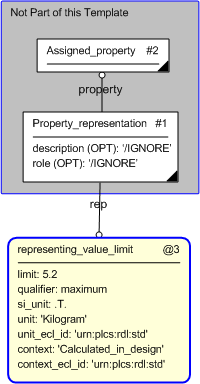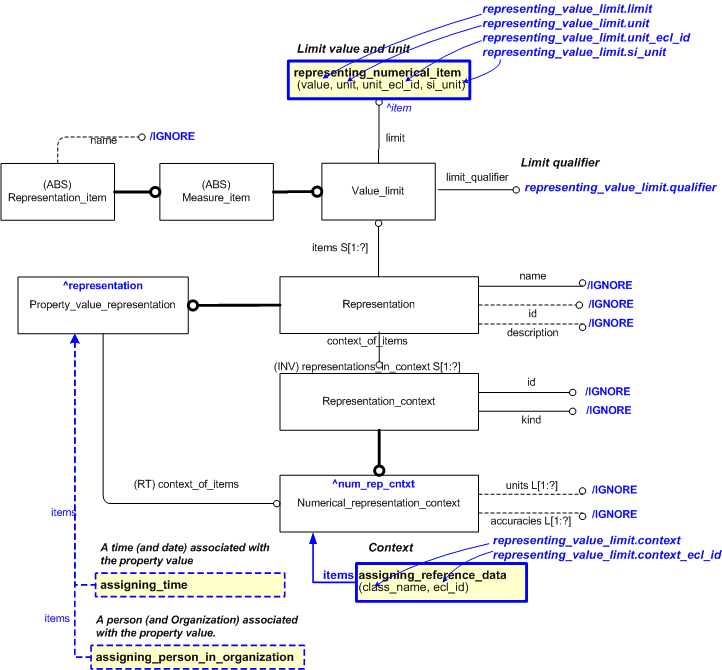| Template:— representing_value_limit (rep_limit) |
Date: 2008/03/07 06:34:59
Revision: 1.24
|
This section specifies the template representing_value_limit.
NOTE
An explanation of a template and the associated instantiation path is
provided in the
Template overview
section.
This template describes how to represent a value limit with associated unit for any property.
EXAMPLE
The maximum weight (in kilograms) of an item.
NOTE
The definition of the property itself (e.g. weight) and the item to which it may be assigned, are not in scope
of this template. This template provides for the value limit and associated unit for the value.
The EXPRESS-G diagram in
Figure
1
shows the templates and EXPRESS entities that are required
to represent the template
"representing_value_limit".
The text highlighted in blue shows the template parameters.
Figure 1 — An EXPRESS-G representation of the Information model for representing_value_limit
The graphic for the template to be used in other EXPRESS-G diagrams
is shown in Figure
2
below.
Figure 2 —
The graphical representation of representing_value_limit template
The following input parameters are defined for this template:
The value of the property.
The datatype is always 'any_number_value' and should not be registered
together with the value i.e. enter the value as a number, without the datatype.
The qualifier of the limit value, either 'maximum' or 'minimum'.
Value should be set to true if the unit is a SI base unit defined by ISO, i.e.
kilogram (kg) for Mass,
second (s) for Time,
metre (m) for Displacement,
ampere (A) for Electrical current,
kelvin (K) for Temperature,
mole (mol) for Amount of substance, and
candela (cd) for Luminous intensity. If this is not the case it should be set to false.
Note that the representation of true and false depends on exchange format. In Part 11 and Part 21 (STEP file) true is
represented by the string ".T.", and false by ".F.", while in Part 28 (XML) they are represented by text
strings "true"
and "false".
The class name of the unit in which the value is expressed.
The following classes and their sub-classes can be used:
The identifier of the
External_class_library
storing the definition of the class referenced by the parameter @unit.
The following classes and their sub-classes can be used:
The identifier of the
External_class_library
storing the definition of the class referenced by the parameter @context.
The following reference parameters are defined for this template:
%^target = $representing_value_limit.representation%
%^target = $representing_value_limit.num_rep_cntxt%
The following parameter combinations specify a uniqueness constraint:
Unique constraint: Unique numerical representation context
There will be one numerical context for the representation of a value.
The instantiation path shown below specifies the entities that are to be
instantiated by the template.
A description of templates and the syntax for the instantiation path is
provided in the
Templates Help/Information section.
The following entities are instantiated with attributes as specified:
The instance diagram in Figure
3
shows an example of the EXPRESS entities and templates that are instantiated by the template:
/representing_value_limit(limit='any_number_value(5.2)', qualifier='maximum', unit='kilogram', unit_ecl_id='urn:plcs:rdl:std', si_unit='true', context='Calculated_in_design', context_ecl_id='urn:plcs:rdl:std')/
(an illustration of the consolidated representing_value_limit template is shown in
Figure
4 below.)
Figure 3 — Entities instantiated by representing_value_limit template
The instance diagram in
Figure
4
shows the graphic symbol for the template that is to be
used in other instance diagrams. The example template is:
/representing_value_limit(limit='any_number_value(5.2)', qualifier='maximum', unit='kilogram', unit_ecl_id='urn:plcs:rdl:std', si_unit='true', context='Calculated_in_design', context_ecl_id='urn:plcs:rdl:std')/
Figure 4 — Instantiation of representing_value_limit template, related to an assigned product property
The following section details how the
representing_value_limit
template can be optionally characterized by assigning
other constructs to it. These are characterizations commonly
applied to the template. The ISO 10303-239 EXPRESS model may enable
other assignments to the entities instantiated by the template.
The EXPRESS-G diagram in Figure
5
shows the possible characterizations of the template
"representing_value_limit".
Figure 5 — Characterizations for representing_value_limit template
The following characterizations may apply:
Characterization Assigning time
NOTE this characterization is optional.
Time (and dates) can be associated with the assignment of property value representation
as in Figure 5. This is described in C079: representing_properties_numerically (NB Capabilities are not documented in this release of the PLCS standard)
, template
representing_numeric_property.
No additional characterization capability is introduced in
this template.
Characterization Assigning organization
NOTE this characterization is optional.
An Organization (or a Person_in_organization) can be associated with the property value representation
as in Figure 5. This is described in C079: representing_properties_numerically (NB Capabilities are not documented in this release of the PLCS standard)
, template
representing_numeric_property.
No additional characterization capability is introduced in this template.





